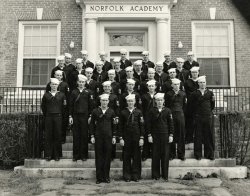
MAY CONTAIN NUTS

Search Shorpy
SHORPY ART

Framed or unframed, desk size to sofa size, printed by us in Arizona and Alabama since 2007. Explore now.
Join and Share
Ad-Free Shorpy
Shorpy is funded by you. Patreon contributors get an ad-free experience.
Learn more.

Recent comments
- Tough Guys
- Lost in Toyland
- And without gloves
- If I were a blindfolded time traveler
- Smoke Consumer Also Cooks
- Oh that stove!
- Possibly still there?
- What?!?
- $100 Reward
- Freeze Frame
- Texas Flyer wanted
- Just a Year Too Soon
- WWII -- Replacing men with women at the railroad crossing.
- Yes, Icing
- You kids drive me nuts!
- NOT An Easy Job
- I wonder
- Just add window boxes
- Icing Platform?
- Indiana Harbor Belt abides
- Freezing haze
- Corrections (for those who care)
- C&NW at Nelson
- Fallen Flags
- A dangerous job made worse
- Water Stop
- Passenger trains have right of way over freights?
- Coal
- Never ceases to amaze me.
- Still chuggin' (in model form)
Member Photos
The Shorpy
Print Emporium
Print Emporium
Search Shorpy
Search results -- 30 results per page
- Naha City, Okinawa c.1969
- ... to revisit that beautiful island!
Memories I loved Okinawa! I was stationed at Kadena AB, Okinawa twice: once in the 80s and again in the 90s. By my time, Naha the base ... Posted by treefrogdk - 01/20/2012 - 9:40pm -
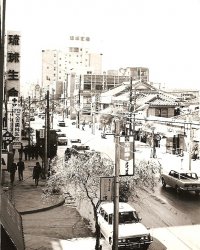
- Okinawa: 1957
- An Okinawa street scene from approximately 1957. The village is called Futenma ... Posted by Groucho - 12/08/2011 - 5:27pm -
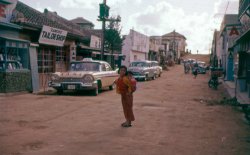
- Christmas in Okinawa
- Theater in Futenma Okinawa, circa 1957. From one of my Dad's badly faded Ektachrome slides. Colors ... Posted by Groucho - 12/21/2011 - 1:11pm -
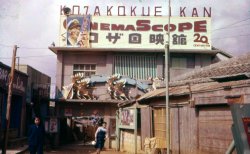
- My First Car: 1972
- ... and unloaded it on another unsuspecting airman.
In Okinawa in 1970 or 71 I saw a Datsun Bluebird, a sweet little convertible ... Posted by tterrace - 03/03/2023 - 12:26am -
![My First Car: 1972 Summer 1972, Lake Tahoe. You'd think, after hearing me rhapsodize about my lifelong obsession with cars, that a) I'd have learned to drive before I was 26, and b) my first car would have been something a bit more spectacular than a 1972 Datsun 1200. That's Nissan to you. Well, I had nice pants, anyway. Not bad for a Polaroid, though scuffed as usual. View full size.
This must be coincidence Sunday...What a coincidence, T. If that photo was from the last week of June of 1972 we may have crossed paths in Lake Tahoe. I was in my '70 VW headed north to Canada on the first leg of a two-month, 10,000 mile, figure 8 trip from Escondido to NYC and back.
I was the one who recognized Sequoia Natl Park. Might as well use my name from here on out, since I seem to be commenting more and more lately. It's gotten bad when even my friends have taken to calling me A. Tipster.
-- Allan
Tahoe coincidenceThis was taken on or about June 21, 1972.
Beats my firstI had a 66 AMC Ambassador that my dad got for free and paid for the "repairs." The two 20-something "mechanics" (one of whom later became a boyfriend, largely to keep the car moving) stuffed the fenders with old T shirts and covered them with Bondo and primer, and put in a rebuilt carb. The problem was they put it in with the butterfly valve upside down. I had to keep a flathead screwdriver in the car at all times because whenever it was the least bit damp (and I live in Michigan) I had to pop the hood, remove the air filter and jam the screwdriver in the valve to hold it open, get back in the car and start it. Then I had to repeat the process in reverse, praying I wouldn't stall. Other than this, the car did what I wanted. Got me the 2 miles to work, and took me road-beering on the weekends.
MemoriesThis reminds me of my first car, a 1972 Toyota Corona. Good times.
My First Car Was FreeDave Kersten gave me my first car because I was the only teammate to pass him the ball (he was the 6'8" center on our basketball team).
It was a 1965 Impala convertible. The last straw against keeping it in his family was when his mother drove the car home in a driving rainstorm because she did not know how to put the top up.
Thanks, Dave.
Datto 1200My first car was a 1200 cc Toyota Corolla. Your Datsun was hotrod in comparison! Datsun 1200s are collectible now, especially in Australia.
[I understand that tterrace himself is wildly popular in Australia, as well as France. - Dave]
My First CarMy first car was a 1962 Rambler I shared with my sister. Its most memorable feature was the pushbutton automatic transmission on the dashboard. It was built like a tank, which was why my dad trusted us to drive it. Top speed: 40 mph going downhill. I don't miss it, but good memories.
Talking Strine[I understand that tterrace himself is wildly popular in Australia, as well as France. - Dave]
Mais oui, mate.
My first car was furrinIn early 1968 as a young airman at Barksdale AFB in Louisiana, I paid $500 for a 1956 Mercedes-Benz 219 sedan. Considering I was clearing $88 a month that was quite a buy. Looking back, it was a piece of junk waiting to fall apart, but the next month I had orders to Vietnam and unloaded it on another unsuspecting airman.
In Okinawa in 1970 or 71 I saw a Datsun Bluebird, a sweet little convertible sportscar which unfortunately was not street legal in the USA.
In 73 I was in college and my girlfriend had a Datsun identical to tterrace's. That relationship fell apart. Since then it's been a steady stream of Hondas.
Identical dented DatsunMy first car was identical to yours, although I bought it in about 1986. It was hail damaged, and it cost $850 Australian. But it's still my favourite of all the cars I've owned. First love never dies!
My first car too!The 1972 Datsun 1200 was also my first car, only mine was green, and had the dealer installed Shelby 12-inch mag wheels and a "Datsun" racing stripe running down the side. I bought it new and paid $2,588 out the door for it. I had a ball in it -- autocrossed and drag raced with my friends on the weekends. It was surprisingly quick for a 1175 cc, 68-horsepower motor. It would hit 90 mph at the end of the quarter mile, and I didn't get beat very often. Now I own real cars though, good old fashoned American Muscle Cars.
Sideways!I had one of these. In the late 80's. I seem to recall it being sideways in the wet any time it rained. It was a sensational car when sideways. The A10 engine used to be modified by some freaks and would reach something crazy like 10000 RPM!!! I believe that the A15 engine in forklifts went well in these. One of the sweetest cars I heard at a sprint meet at Philip Island was one of these with a 2L OHC engine with twin Webers. It was also the fastest lap time around the track that day. The only weak thing in my car was the gearbox. The rocker post bolts used to strip out of the head very occasionally on the A10, otherwise excellent powerplant.
VroomDefinitely kinda cute. Car's not bad, either.
(ShorpyBlog, Member Gallery, Cars, Trucks, Buses, tterrapix)](https://www.shorpy.com/files/images/SHORPY3649.thumbnail.jpg)
- D-Day: New York
- ... forget how brave these men were. My uncle fought in Okinawa in 1945, unfortunately he never made it out alive. I still have the ... Posted by Dave - 06/06/2013 - 10:25am -
![D-Day: New York New York, June 6, 1944. ALLIED ARMIES LAND ON COAST OF FRANCE. GREAT INVASION OF CONTINENT BEGINS. "D-Day. Crowd watching the news line on the New York Times building at Times Square." Photo by Howard Hollem or Edward Meyer for the Office of War Information. View full size.
Unidentified ObjectDoes anyone know what the curved metal object with letters on it is? It appears to be on top of a car on the right.
[DeSoto "Sky View" taxicab sign. - Dave]
Internet, 1944is what this could have been titled. The scrolling electric sign was as good as it got then, and I am sure those folks were fairly amazed to see it. I wonder what it took to program it?
My great-uncle went in at D Day +60 (August 7) as a replacement in the 2nd Infantry Division (L Company, 23rd Infantry Regiment); he was seriously wounded at Brest, France, a month later, died in 1956...and I was named for him.
That was never far from my mind when I served in Iraq in 2004 at the same age he was when he earned his Purple Heart and (I believe) a Bronze Star.
To all those who went in on D-Day...and throughout WWII, I stand and salute.
So what about that moving sign?According to various sources the NY Times installed the first moving "news ticker" in 1928, using 14,800 electric bulbs. Given the technology of the day, I can only guess that each bulb required a relay, which would have to click on and off almost instantly to momentarily light its bulb, as the text scrolls along. This must have been a maintenance challenge (there seems to be a few extra bulbs lit, and some brighter ones that may just have been replaced). They may have used or even invented the "matrix" technique still used today for LCD displays, which uses "crosspoint" wiring to greatly reduce the number of lines going from the elements to the control system, but my mind still boggles at the number of wires remaining, and what kind of electro-mechanical system translated "operator input" to the streaming text. If only Shorpy's world-wide readership included a retired electro-mechanical sign technician!
Just the technology of the news line was something...Before zooming in to see the image full size, on first glance the guy on the left and the guy 2nd from the right were in a posture not to different than someone holding a cellphone to the ear. Of course it's clear they were dragging on fags, sucking on coffin nails, drawing down on Pall Malls while taking in the portentous news. As someone not born until 12 years after the war was over - I am fascinated by what day to day life in the US was like, mobilized for war. Of course I grew up knowing it was a success, but at that very moment, who knew how this was going to work out - the intensity of the moment, even for folks in the street in Times Square, must have been incredible.
Pausing to rememberMy brother landed D-Day plus 12 and my uncle D-Day plus 20. They were lucky, I guess, and returned to us to live out long lives. Great photo. Really profound.
6-6-44Yet to be born, a twinkle in my father's eye as he dropped from the sky into Caen with the Canadians early that morning. RIP Dad.
23,740 days later
Kind of Gladwe can't see many faces in the crowd. We'd have to start wondering what they were thinking -- Is my son there? My dad? My husband? My brother?
Funny but I cannot summon up any memory of D-Day. VE and VJ Days, and the dropping of the two A-bombs are sharp and clear, but not D-Day.
I think perhaps that it might relate to what happened in early May. I was out riding my trike when a Western Union messenger rode up on his bike and went into the three-family apartment in which I lived. I heard a terrible scream through the open windows of the first-floor unit. All the neighbors (women since the men were in the military or working) flocked to the apartment with screams continuing for some time. I learned that the woman's son had been killed in action.
I did not totally understand the horror, but I was sad because the young man had been very nice to the punk kid airplane nut from the third floor, even letting me hold his model planes.
The first-floor family were an elderly couple, with the one child, who had become a fighter pilot in the Pacific. The husband walked with heavy braces and crutches, and, as I later learned, they just quit and gave up life. They moved within days and we never heard from them again.
I think that I was in a bit of a void for a while.
Walking to churchOn January 6, 1944, I was 6 years old in Fort Smith, Arkansas, part of a young generation which at the time had no knowledge of a condition known as peace. On that day, my mother received a phone call from a fellow church member who was calling everyone in the congregation to say that the invasion was under way. This was the signal to come to the church to pray. Our family; mother, father and two boys walked to the church to pray for the safety and success of our "American Boys" on that day.
DeSoto Sky ViewThose great old DeSoto cabs had a sliding roof panel to let passengers see the views above them while being carried through the Manhattan canyons. The skyscraper with the clock housed the Paramount Theatre, a wonderful place to visit for a movie and a live stage show. I saw Phil Spitalny and his "All-Girl Orchestra featuring Evelyn and her Magic Violin" there with my family. The movie was "Miss Susie Slagle's," starring Veronica Lake and Sonny Tufts.
Bright Lights, Big SignRadio CoverageThe National Archives in College Park, Maryland has recordings of the entire NBC and CBS broadcast day from D-Day and anyone can go in and listen to them. It's a very good way to get a sense of what the day was like for people at home listening on the radio as events unfolded.
News ZipperFrom a 2005 NYT article on the Zipper:
The Motograph News Bulletin, to use its original formal name, began operation on Nov. 6, 1928, election night, as a band of 14,800 light bulbs that extended 380 feet long and 5 feet high around the fourth floor of what was then the Times Tower. It was installed for The New York Times by Frank C. Reilly, according to an article in The Times, which identified Mr. Reilly as the inventor of electric signs with moving letters.
Inside the control room, three cables poured energy into transformers. The hookup to all the bulbs totaled 88,000 soldered connections. Messages from a ticker came to a desk beside a cabinet like the case that contained type used by old-time compositors. The cabinet contained thin slabs called letter elements. An operator composed the message, letter by letter, in a frame.
The frame, when filled with the letters and spaces that spelled out a news item, was inserted in a magazine at one end of a track. A chain conveyor moved the track, and each letter in the frame brushed a number of electrical contacts. Each contact set a light flashing on Broadway.
There were more than 39,000 brushes, which had to undergo maintenance each month. The frame with the letter elements passed up and overhead, forming an endless circuit. Mr. Reilly calculated that there were 261,925,664 flashes an hour.
D-DayJune 6, 1944, I was 16 years old and in Basic Training with the the US Maritime Service at Sheepshead Bay, Brooklyn. Many of us teenagers had close relatives in the military and wished we were there with them to fight the Axis. A month later, I was in a North Atlantic convoy assigned to a 20 mm anti-aircraft gun hoping that a Nazi plane would dare to fly over. "I'd show 'em." Of course I didn't tell this to my shipmates.
skyview cabI believe this is the light-up sign on top of the Sky-View Cab Company. It looks like neon. I was watching an old movie from the forties (?) on TCM and I noticed these cabs. They had a sunroof cut into the roof of the cab so the passengers in the back seat could look up and see the buildings. I can't remember the movie, but the plot involved the passenger looking up and seeing something relevant to the story line. It must have been a gimmick for the cab company. It also must have been one of the early sunroofs in a car!
More SkyviewThe Skyview NYC Taxicab that the tipster may have seen on TCM was in the musical "Anchors Aweigh". The scene where Frank Sinatra and Gene Kelly are Standing up and looking out at the city in Betty Garrett's Skyview cab. Those DeSoto Skyview Cabs were sold exclusively through James Waters Chrysler Agency in Long Island City, Queens.
The price for a new one was about $1100. I once heard a story that he was Walter Chrysler's Son-in-Law but I can't confirm it.
The Skyview cabs were all over the placewhen I lived in NYC from 1941 - 44. They were stretched DeSotos with a couple of fold-up seats and the roof had glass so that one could see the tall buildings. There was also a radio built into the armrest on the right. The driver turned it on and the passenger controlled the rest. I had many rides in those cabs.
Hovercraft at D-Day@sjack: I don't mean to rain on your parade, and I certainly don't wish to denigrate the memory of your father and his courageous service to our nation in World War II, but I'm quite sure he didn't lower tanks onto hovercraft for the D-Day invasion of Normandy. The US Army did not make use of hovercraft until Viet Nam, and then it was only on an experimental basis. As your comment is titled, memories are funny sometimes.
Perhaps your dad talked about loading tanks onto landing craft, not hovercraft, like the LST (landing ship tank) or smaller versions like the LCU (landing craft utility), which were flat-hulled vessels that could approach fairly close to the beach and lower a ramp on the bow, allowing troops and vehicles to exit.
The Bronx is up but the Battery's down"New York, New York, A Helluva Town" was sung in the Broadway "On the Town" but for the film changed to "New York, New York, A Wonderful Town" because of those archaic Hollywood codes at that time. Los Angeles may have our Dodgers but they don't have our songs or our Skyview Cabs.
RememberingDuring my early teen's in the 1950's I was invited along on several fishing trips with 3 WWII veterans. One had been an Army Ranger, one a sailor who had been on the Murmansk Run, and the third a paratrooper. You can imagine the banter among those guys. The Ranger was in the D-Day invasion and had been wounded in the buttocks. The Navy vet always asked him how he could have sustained that injury advancing from the beach. Curiously, the paratrooper never spoke any particulars of his service. They're gone now, but I remember them being nice to this kid. Thanks guys.
UnawareJune 6, 1944 - I was happily gestating in my mother's womb and would be born during the Battle of the Bulge (no relation to mom's condition). My dad, drafted in 1940 into the 7th Cavalry (yes, Custer's old outfit) had been converted into armor and was preparing to sail overseas to a place called Leyte Gulf in the Philippines where he would be wounded and spend the rest of the war, plus another year, in Letterman Hospital in S.F. Until his death in 1996 he could remember most of his company's buddies names and the names of their horses.
More on radio coverageThe NBC and CBS D-Day broadcasts are available at the Internet Archive.
NBC:
http://archive.org/details/NBCCompleteBroadcastDDay
CBS:
http://archive.org/details/Complete_Broadcast_Day_D-Day
That woundHow your Ranger probably caught that one: We were taught in training that buttocks wounds were very common; moving forward under fire without decent cover, one crawls. It is most difficult to accomplish this without making your buttocks the highest point of your body!
Let us never forget the men of D-Day.An awful lot of them gave up their tomorrows so we could enjoy our todays.
'On The Town'Is the movie 'Mr. Mel' is thinking of; 'Anchors Aweigh' is set in Hollywood. Right Stars, wrong movie.
'Lest We Forget'A line from Ford's 'She wore a Yellow Ribbon' that fits this day so well.
Odd TriviaThere are a couple of boats trading on the Great Lakes today that were at the Normandy invasion. One still carries the battle ribbons with stars on her bridge wings.
One other point is that the Times building was of very attractive design before it was covered up with billboards.
Communiqué No. 1I followed the NBC link provided by hlupak604 and listened to some of the radio coverage and heard, more than once, the short text of Communiqué No. 1 from Supreme Headquarters, Allied Expeditionary Force, which appears to form the basis for the scrolling text on the news zipper. It runs as follows: "Under the command of General Eisenhower, allied naval forces, supported by strong air forces, began landing allied armies this morning on the northern coast of France."
Thanks! Uncle SamMy uncle Sam (no pun intended) landed at Omaha Beach, and immediately sustained an injury to his head. He was fitted with a metal plate to replace the part of his skull that he lost. Needless to say, his fighting days were over.
However, he went on to be become an accomplished auto mechanic. Family, friends, and neighbors all asked him for automotive advice.
He passed away last year at the age of 90.
Thanks, Uncle Sam! - because of your sacrifices, I am free today to write this.
Yeah, I remember.Although we didn't know it at the time, my brother was in the sand of Utah Beach just then. He survived the war. I remember vividly the headlines in The Detroit Times that afternoon, "WE WIN BEACHES". Due to the time difference, of course, there was plenty of fresh news of the invasion in the afternoon paper. I've been a news junkie since.
May we never forgethow brave these men were. My uncle fought in Okinawa in 1945, unfortunately he never made it out alive. I still have the last letter he wrote to his "beloved mama", what a sweet soul he was. Bless them one and all.
Memories are funny sometimesMy father was on a supply ship in the English Channel on D Day, lowering tanks into hovercraft that were being sent to French beach heads. Many, many, times I tried to discuss his experiences that day but he never really had much to say. He said that on D Day he was "on the water" (in the Channel) and they were pretty much working constantly getting the tanks loaded and shipped. They slept whenever they could he said. He landed at Utah beach (but didn't say when) and moved up the coast doing whatever was asked (he was in a supply unit) until he got to Belgium. And that was pretty much all I got out of him. His shared memories of the battle of the Bulge were even more meager ("it was very cold"). I'm jealous of people whose fathers discussed their war experiences; mine just didn't seem to want to share.
Cold for JuneI realize most people dressed up in public back then, but most of the women in the photo are wearing overcoats. It must have been cold in New York that June day in 1944.
Hovercraft tanks, sort ofOne of many unique innovations for the D Day invasion was the "Duplex Drive" tank, essentially a standard Sherman tank which was fitted with an inflatable, collapsible canvas screen and twin screw props which would enable the tank to float like a boat and wade ashore.
Unfortunately, the contraption worked best in calm water, something that was in short supply off the Normandy coast that day. I remember a buddy of mine whose dad had served with the US Navy at the invasion re-telling his dad's stories of the DD tanks being dropped off in deeper, rough water due to enemy fire and sinking like rocks.
Fortunately enough of the tanks were able to make it on shore to provide badly needed armor support for the ground troops, and the tanks were deemed successful enough to serve in the invasion of Southern France two months later, as well as during numerous river crossing operations during the remainder of 1944 and 1945.
Good article with photos of the tanks:
https://en.wikipedia.org/wiki/DD_tank
Full messageI believe the full message read: "ALLIES LAND ON NORTHERN COAST OF FRANCE UNDER STRONG AIR COVER"
(The Gallery, Howard Hollem, NYC, WW2)](https://www.shorpy.com/files/images/8d36243u.thumbnail.jpg)
- Agri Culture: 1942
- ... would be All-American in 1942. (Schreiner was killed on Okinawa in 1945.)
Curry's job at Wisconsin sounds like something I would ... Posted by Dave - 01/24/2023 - 4:27pm -
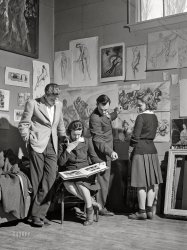
- Dairy Queen: 1977
- ... Air Force Base? That's where we moved when we left Okinawa, and where I spent the 6th grade (so it would've been 1973, '74). ... Posted by rizzman1953 - 05/12/2012 - 2:33pm -
![Dairy Queen: 1977 Late one evening, summer of '77 on Mount Auburn street in Watertown, Massachusetts; it is now long gone. I loved the sign and the car. Taken with a 4x5 view camera. I can still taste the ice cream -- dipped in chocolate of course -- and the sticky fingers. View full size.
Twenty-two-year-old Buick on snows!That 1955 Buick Special two-door sedan appears to be wearing a set of snow tires on the rear. Wonder why it'd have them on during the summer? After all, if that car was driven during twenty-two Massachusetts winters it would've rusted completely away.
Rizzman rocksI do hope you publish a book of your photos at some point. They are really strikingly beautiful. Thanks for this latest.
ShenanigansI am positive more than one fellow Shorpian will know what Marvel Mystery Oil is. Back in the late 50s when my ride was the Chevy V8-powered '54 Studebaker you see here, posed next to my friend Roger's chopped '48 (I think) Mercury ragtop, we hung out at Ted's Drive-in Diner in Altoona, Pa. One summer night one of the guys filled his windshield washer bag with Marvel Mystery Oil, ran the hose into the top of the carburetor of his '57 Ford convertible, and while someone held the diner's door open, backed his car as close to it as he could and triggered the windshield washer pump. An hour later the place was still pretty much swimming in Marvel Mystery Oil smoke. Ted was the opposite of well-pleased.
How to in digital?This is a beautiful shot taken in the days of analog photography.
How would you accomplish this with a digital camera?
[The same way. -Dave]
So dreamyThe lighting is phenomenal! What a great surreal/hyperreal quality. I want to go to there.
Stunning! Holy CRAP!!
What an incredibly well-done picture this is!
I'm reminded of Ansel Adam's "Moonrise Over Hernandez New Mexico" -- he was driving along, saw the shot developing and jumped from his car, set up his camera and took it, then, while reversing the slide for another, the light changed and that was that!
My 'umble opinion is that your image is in this class.
Boy that looks familiarWould you know if this was anywhere near (what was then) Westover Air Force Base? That's where we moved when we left Okinawa, and where I spent the 6th grade (so it would've been 1973, '74). Looking at this shot I can almost FEEL myself walking in that door again. Maybe it was on the route of one of the many sightseeing trips my family took, but this is an incredibly evocative picture (and thank you for it); I'm SURE I've been there.
MemoryI used to love this place. My grandfather would often take me there.
So reminiscentof my first trip to the United States to Glasgow, Montana, from Moose Jaw, Saskatchewan, in the 1950s, long before Dairy Queen came to Canada. I kept the milkshake container for years.
Another great picture!Love these night shots, like a scene from a movie!
Director yells "Action" two guys with stocking masks come running out of the DQ, they jump into the Buick they backed in for a quick getaway, they burn rubber out on to the street and take off into the night. Cue Rock & Roll Soundtrack.
"Summer air"The snow tires still on in the summer? About 30 years ago an old lady came into the shop wanting us to put summer air in her tires and take out the winter air. Seems another shop had been charging her $5 to do this twice a year to go along with the snow tire removal in the summer.
And the oil spots under the engine were the norm, as was having to feather the gas pedal on a cold winter startup because the choke was finicky. Sometimes you had to put a stick in the choke to get the engine started.
1955 Buick SpecialIt is rather clean looking to be a 22-year old car in 1977.
Yep, that's summer in balmy New EnglandSnow tires.
EmissionsThe noticeable soot from a tailpipe on the wall of the DQ shows an incredibly rich mixture, probably a choke that was stuck closed. These old behemoths broke down a lot, required annual valve jobs and tuneups and it was just understood this was the way it was. Now you can go over 100K on a set of spark plugs, and I can't rememeber the last time a car came in for a valve job.
Those were the days, indeedThe snow tires (studded?) in summer suggest a number of possible scenarios. Maybe the 22 year old car was owned by a high school kid working at DQ for the summer, too poor to buy a conventional set. The chrome strip at the base of the car between the rear wheel well and bumper is aftermarket. (JC Whitney?) Maybe someone was trying to cover up a little rust, or perhaps the owner didn’t think Harley Earl had arranged enough chrome on the model. I understand Earl was particularly partial to the 55 Century, which looked almost identical to the Special. (The Century had four portholes.) The grille of the 55 was, like Earl himself, massive and imposing, if not charming. It may be a bit trite to say it, but it’s an unmitigated fact: those were the days, my friend.
Big BusinessDairy Queen, those local roadside ice cream stores are now part of the Berkshire Hathaway conglomerate. The now approximately 6000 world wide locations were purchased by Warren Buffett's company in 1998. Berkshire Hathaway's class A stock closed on May 11, 2012 at $122,795 a share.
Update:
Nov 28, 2014 closing price $223,065
Film NoirThank you Rizzman for another beautiful moody nightshot which brings back memories of my father's solid black '55 4-door Buick Special V-8. Also, I love that Eskimo sign which reminds me of Dairy Queen's old jingle singing "the cone with the curl on top". With your obvious talent for photography, I hope it is still a big part of your life. The purpose of any art is to get an emotional response from the viewer and you have definitely touched the Shorpy audience with each and every one of your shots.
Ice Milk, not Ice CreamI worked in a DQ in the 1970s while attending high school in Vancouver, B.C. The product we served was called "ice milk," lower in fat than ice cream. I have no idea what they call it now in Canada but Google suggests that in the US it is now called low-fat ice cream. Restaurants were either a "Sizzler" (electric flat grill) or a "Brazier" (gas BBQ type grill). Some would get confused and try and order a "brassiere" burger.
The first DQ opened in Canada in 1953 in Estevan, Saskatchewan.
[In its early years, Dairy Queen advertised its product as "freshly frozen dairy food." - Dave]
ZZZZZTTTT!!!!Great shot. You can almost hear the sound of the bug zapper.
Blizzard anyone?Seeing this picture reminds me of my Uncle George who always made it a point to stop at the Dairy Queen on any adventure trip we took. Usually, it was stop once on the way there, and once on the way back; a double shot of ice cream fun. I also remember him telling a story from back before I was born. One of his other traditions was to take my sisters to the Dairy Queen on the last day it was open for the season (usually November 1st in Maine). He would always tell my sisters they had to wash their hands and faces before they could go. One year, there was a blizzard on the last day of "ice cream" season, and my uncle had stopped by to visit my father. He had no intention of going to the Dairy Queen (due to the heavy snow) and figured my sisters wouldn't think of it either. My sister Sue came running out to the kitchen and began tugging on my uncle's pant leg. He ignored her for a while and she went away. A few minutes later, she was tugging at his pant leg again, and when he looked down, she was there with a washcloth, washing her face and smiling up at him. He felt so guilty he packed them all in the car and took them out for ice cream. The Dairy Queen attendant said they had actually planned on closing early because they hadn't seen any customers up until them. Since my uncle's passing in 1992, I have had to assume the role of "Uncle George", and whenever taking my nephews and nieces (or their children) on adventures, we always make plans for a stop at an ice cream location. Some traditions are just worth hanging on to.
Uncle George: The Next Generation
Great PhotoGreat Photo, wrong location. I grew up in Wtaertown and have many family members and friends there. There was no Dairy Queen on Mt. Auburn St. There was however a similar establishment called Dairy Joy. It also sold soft serve ice cream, burgers, hot dogs, fried fish, etc. I can see how the two places could be mistaken for each other. Keep the great pictures coming, I love ice cream and old cars.
[Perhaps rizzman will chime in to clear this up. He took the photo. - tterrace]
Wish I'd done thisI know from an earlier photograph, that these were done as part of a photography class, but I wish I'd gone around my town and taken night photos like these while the icons of my teenage years were still standing.
I could be wrong about the locationMy memory could be faulty. It could have been any community around Boston including Route 1, but surely within a less than 25 mile radius. Sorry if I misled anyone.
Dennis the MenaceYup, I remember when DQ used him as their mascot in the 70's!
I still love DQ, but they have apparently stopped using the term "parfait"; a few years ago I had asked for a strawberry parfait and the girl at the counter just stared at me like I was crazy!
What's sadder is that I remember them still using the term a recently as a year or two before that incident, but at least the same product is available, it's just simply known as a strawberry sundae.
Best DQ I ever went to was in Jedda, Saudi Arabia - they kept everything spotless and the ice cream perfect in case King Fahd dropped it! :)
(ShorpyBlog, Member Gallery)](https://www.shorpy.com/files/images/dq2_.thumbnail.jpg)
- Douglas MacArthur: 1930
- ... we had.
By counter-example, much of the bloodbath of Okinawa would have been sidestepped had he been in charge there. His plan was ... we gained control of a large swath of central and northern Okinawa quickly and with low losses.
MacArthur could see no point in ... Posted by Dave - 08/07/2012 - 9:28pm -
![Douglas MacArthur: 1930 November 1930. Washington, D.C. "MacArthur, Douglas, General." Pipe, corncob, evidently at the cleaners. Harris & Ewing glass negative. View full size.
ComparisonI couldn't help but compare General MacArthur to this clown:
https://www.shorpy.com/node/6645
MacArthur MagicWhy, just 15 minutes ago Doug had the cigarette in his left hand and the medals pinned over his right breast.
[A speedy about-face. - Dave]
Phillipines, TheReturn, shall I.
The sameDouglas MacArthur who two years later in D.C. led troops against World War I veterans and their families protesting to get their bonus pay.
Nuke 'em !And to think that 21 years later, he was willing to nuke China ... He does not appear so rabid in this picture !
Interesting featureInteresting plane of focus with his pants going soft very quickly, together with his right shoulder but not his left.
Character StudyPerhaps it's only my perceptions, filtered through a knowledge of what was to come for McArthur, but it seems to me you can see a great deal in this: his expression shows self-confidence, almost arrogance; an instinct for how he's viewed by the camera; nattiness of dress (although what's up with the knitted tie?); and a kind of superciliousness.
Yet to come were Corregidor and Korea and the Old Soldier fading away....
Not long before attacking his own sideThe Bonus Army (WWI Veterans) marched on Washington during the Depression, and MacArthur and Eisenhower were instrumental in running them out of town. Tsk Tsk.
New Chief of StaffIn November 1930 he became Army Chief of Staff and was promoted to full general (four-star) from major-general (two-star). He's wearing four here, so it would have been just after the promotion I think.
This is a pretty remarkable attainment for a guy who had just turned 50.
Appropriate for the Leyte invasion anniversaryOctober 20, 1944
A DandyNot bad for a kid who spent his last three years at West Point living off post with his mother.
Generally speakingA REAL gentleman!
MacArthur Military MuseumI shall return to this museum in Little Rock to see a display of photos from the Vietnam War by two journalists that served there in the 60's. This museum is an old military arsenal from the middle 1800's and happens to be the birthplace of the general in 1880.
Dougout DougLooking rather spiffy in front of the oft-occasioned camera.
Living Off PostI guess that's why he graduated top of his class. An amazing amount of negative comments for a man whose contributions to this nation were so great as to even enabled a cottage industry of heelbiters.
Dirty Doug"Doug" kept a mistress for quite a number of years Isabel Rosario Cooper, a Filipino actress whom he met when she was 16 years old. Her pet name for him was "Daddy".
He is famously reported as having given her many gifts but no raincoat because "She didn't need one ... her duty lay in bed".
Captures the whole manA mix of brilliance, arrogance and probably more than a little entitlement. I'd love to see a picture of his father, Arthur MacArthur, sometime.
Men-o-WarMany of his staff and other soldiers under his command in the Philippines referred to him as Dugout Doug. One has to wonder why, when another American Army general halfway around the globe was "Old Blood and Guts" Patton. For all practical purposes, MacArthur sat out the war while his subordinate commanders fought and died. Meanwhile Patton was in the thick of it. Even MacArthur's "I Have Returned" publicity photo on the beach at Leyte was staged.
RoyaltyIt was almost as if MacArthur was really looking to be King of the Philippines. He formed the country's army in the 1930s but it wasn't ready for the Japanese attack in 1941. It was rumored that he had vast personal holdings there. He was Field Marshal of the Philippine Army (a rank that didn't exist in the U.S. Army). After Pearl Harbor he led the U.S. to victory in the Pacific, but when North Korea attacked South Korea in 1950, and the Chinese Red Army went to the aid of the North, he wanted to nuke China and President Truman objected, called him home, and fired him. Truman's action as Commander-in-Chief effectively ended his military career and solidified Presidential command of the armed forces. Some felt that he should have been the Republican nominee in 1952 presidential election but the GOP wisely chose General Dwight Eisenhower, his archrival.
Forward to 1942Following the loss of the Philippines, Dougout Doug (as my father also called him) was awarded the Medal of Honor for his failed defense. His father, Arthur McArthur, was awarded the Medal of Honor for his 1863 bravery at Missionary Ridge. I have looked for, and never seen, a photo of Doug wearing the Medal of Honor or the ribbon. I think in 1942 he was so ashamed to have received the Medal of Honor that he gave up wearing decorations for the remainder of his life.
He certainly was not camera-shy, and if some one can find the photo I am looking for I would like to see it.
General StudiesHere's someone who spent a fair amount of time in front of a mirror. Note the jaunty tilt of the off-center cap. Bravo.
Power MacFor years, my opinion of MacArthur ran much along the lines as yours. What changed it was reading "American Caesar" by William Manchester.
MacArthur was arrogant, flamboyant, conceited, and in every way a prima donna, who both used and relished media showboating. And despite the brilliant Inchon invasion, he deserved being fired by Truman for his insubordinate statements regarding how to deal with North Korea and China.
But he was also an extremely able general, who consistently kept several steps ahead of the enemy. Moreover, he took and held more territory with a smaller loss of lives on our side than any other WW2 general we had.
By counter-example, much of the bloodbath of Okinawa would have been sidestepped had he been in charge there. His plan was to capture enough of the island to provide us with airbases for attacking the home islands. This was achieved early in the campaign, as the Japanese decided to let us land essentially unopposed. As a result, we gained control of a large swath of central and northern Okinawa quickly and with low losses.
MacArthur could see no point in spending thousands of American lives to root out the Japanese army in the south of the island, where they had dug in for the usual to-the-last-man defense. Instead it was better, he thought, to use the Army and Marines to keep them bottled up there at low cost to us.
And, finally, he ran the postwar occupation of Japan much better than anyone else likely could have.
(The Gallery, D.C., Harris + Ewing, Public Figures, WWI)](https://www.shorpy.com/files/images/18374a1.thumbnail.jpg)
- The Rat Patrol: 1973
- ... and 70s (turned 10 in 71). I spent most of my childhood on Okinawa, mostly living off base. My brother and I would comb the jungles for ... Posted by AmericanJarhead - 09/12/2011 - 5:55pm -
![The Rat Patrol: 1973 This is my brother Paul (right) with a friend, Danny Bergman, who lived four or five houses down the block. It was taken in 1973 on the driveway in front of our house in Huntington Beach, California. I built the "machine gun" for them from spare pieces of PVC, wood and assorted hardware that were lying around in the garage. Next, I nailed a belt of machine gun ammunition to the block of wood and voila, a "machine gun" ... I used to go hiking with my father up in the dusty hills of Camp Pendleton where I collected spent rounds and belt links from the range. (At the time, I had no clue that I would end up hiking those hills again in 1979 and 1980 as a Marine myself! Or did I?) When I got home, I would reassemble the brass casings with the belt links and make lengthy ammunition belts. In the late sixties and early seventies I always had an ammo can with ten or so feet of belted machine gun rounds. My friends and I played "Army" a lot back in the sixties. Anyway, my brother and his friend would go around playing "Rat Patrol" and blow away all sorts of imaginary suburban enemies. In the garage is my parents 1972 Fiat 124. I never got to drive that thing but it was a dog of a car from what I remember. They ended up replacing the Fiat with a light blue 1975 Volkswagen Rabbit. I learned to drive in the 4-speed manual Rabbit while I had my learning permit. I got my license on the day of my sixteenth birthday and drove the Rabbit until 1976 when it was sold after being involved in an accident. I was not driving it at the time! Scanned from the original 110 negative. View full size.
What goes aroundFantastically good scan from 110 negative! Thanks for sharing, and thank you for your service to this great country.
NiceWouldn't that be Rug Rat Patrol? That's insanely cool, especially with the ammo belt made up from the real thing. The Fiat might've been a dog, but that's a great color for that car.
(Yeah, I asked if you strapped that thing on, but it got edited out. Grr.)
[Part of your comment did not show up because it contained invalid characters. - Dave]
Shocked. Shocked!No helmets? And children allowed to play with toy guns? How times have changed.
Accident Waiting to Happen...As I look at the photo, I can't believe that the gun and my brother didn't fall off and hurt themselves. I don't know how they managed to keep upright!
As for helmets, we rode bikes, skateboards and mini-bikes without helmets because nobody did. I don't remember when the helmet PSA's started appearing but is couldn’t have been too much later than this.
I was surprised at the quality of the scan on this too. Some of the 110 negatives that my mom shot were terrible but this one and several others were most excellent. This was scanned with the Nikon Super Coolscan 5000ED.
I will post some more soon. I have a technical issue which Dave (Shorpy's own) helped me resolve.
Holy Cow!My brother and I used to play Rat Patrol on vacations at the beach back when it wasn't a federal offense to play on the dunes. If we'd had that dune buggy rather than our two spindly legs, we would have destroyed all the sea oats on Topsail Island, NC.
For more Rat Patrol goodness, I give you:
http://www.imdb.com/title/tt0060018/
Fiat GreenI had a Fiat 131 in the same shade, though I think this has printed out a little light. At least in the late 1970s it was closer to glossy olive drab. I had a Rabbit too, later on.
The thing that resonates for me the most, though, is the tank top. That's such a '70s boy's shirt.
Iron-on!Looks like Danny needs some iron-on knee patches. When I was 9 in 1973 I had "Tough-Skin" jeans in assorted colors -- when the knees started to give out my mom would iron on plastic color-matching patches. Which made my knees sweat. And I could never figure out why my jeans never faded like my older brother's.
Oohrah!Yes we played with toy guns and enjoyed Rat Patrol and movies about war.
When we weren't playing with toy guns, we were practicing with real ones. I got my first rifle for my 5th birthday. Didn't get a BB gun until I was 7, maybe 8.
Fun. Italian. Auto. Transport.They started making the Fiat 124 in 1966. The Russian Lada factory is still making a version of it.
Love the wheel chocks, and Yes, my kids have that wagon (in red).
I remember being mocked when my cousin & I pedaled around his block in Cerritos wearing motorcycle helmets.
Also, those are pretty odd shoes for 1970's SoCal, Danny. As I recall, it was pretty much just Converse, Vans, Adidas, Lightning Bolt flip-flips and anything from Sears.
Rat Patrol. Great job of making that machine gun. Always fun to make something cool from a pile of junk. Kids with imagination and skills.
Ever notice in the weekly beginning of "Rat Patrol," the guy absolutely destroys himself on the machine gun as they crest over the sand dune? Ouch.
Also, the lead actor in the series eventually died from injuries incurred while filming the series years later.
Rat PatrolPlaying "Rat Patrol" and "Combat"...Our dads had enough WWII souvenirs (ammo belts, helmets, etc) still lying around in basements and attics that we could kit ourselves out, but I admit we never had such a cool machine gun!
(I always had to be the bad guy because I could speak German).
Fix it again, TonyWe had a nearly identical Fiat, except in powder blue. It was a lemon, and then was squashed like a bug when my neighbor forgot to set his parking brake and his car rolled down the hill, across my lawn and right onto the Fiat.
Not Just a Radio FlyerIt's the flashy Radio Flyer GT, with mag wheels and whitewalls!
Fiat 124, film 110I nearly bought a 124 in 1981, but got another Rabbit instead, the right decision I think. Still cool to see it in the garage there.
Nice job on the 110 scan. So far I've only scanned slides from 110, which are often not very well exposed; I'm hoping I can get better results, maybe comparable to yours, when I get into the negatives.
Thanks for the memories...This picture made my week.
I grew up in the 60s and 70s (turned 10 in 71). I spent most of my childhood on Okinawa, mostly living off base. My brother and I would comb the jungles for WWII surplus (tons of it! Oh how I wish I would have saved some of those treasures) then we'd play "Combat" and "Rat Patrol" with the stuff we found. Getting to play soldier in a sho'nuff Asian jungle ... MAN I loved being a kid.
Avocado see youSome classic 1970s colors here. Wow.
Dart WarsThat suction-cup dart on the ground, what was that from? I love that it's in that same pukey shade of green.
Waffle Stompers!Our kids wore them in the late 60s early 70s when we started going camping and hiking in the summer. Good shoes to wear for all the rough stuff, including going out to the desert to shoot model rockets. (After the rocket landed much time was spent trudging through sand and rocks searching for it.) Practical too. Though they cost more than Vans, they didn't wear out as fast. Plus, they would be outgrown by the next summer, so might as well get use from them.
-- Former SoCal Mom
Field Marshal Rommel beware.Christopher George has nothing on these guys.
Things ChangeGreat photo!
It's interesting to compare this picture to "A Heavy Load: 1909," and meditate on just how much American childhood changed in less than 70 years.
Star Wars Storm TrooperCheck out the shadow of the kid and gun.
Great memory!I was at Camp Pendleton twice, two weeks in 1976 at Devil Pups and again in platoon 3001 MCRD SD 1979.
Great memories of growing up in California!
SameI had a similar toy a friend of my dad built for me in the fifties. He put a motor with a battery and playing card inside so that when I pressed the trigger, we could pretend the noise was the gun firing. Similar to the noise a playing card in bicycle spokes would make.
(ShorpyBlog, Member Gallery, Kids)](https://www.shorpy.com/files/images/paul.thumbnail.jpg)
- BFF: 1938
- ... concur with History Lover's assertion. While stationed in Okinawa in 1970, I knew a USAF Chief Master Sergeant who had been in the Hitler ... Posted by Dave - 04/08/2014 - 1:29pm -
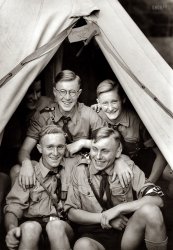
- Teen Arsenal: 1959
- ... too, most notably in New Guinea, the Philippines, and Okinawa. It's even possible that Dad was still in the Army and stationed at ... Posted by Dave - 11/28/2018 - 9:51am -
![Teen Arsenal: 1959 From Columbus, Georgia, or vicinity circa 1959 comes this uncaptioned shot of the young marksman last seen here. 4x5 inch acetate negative. View full size.
We need a reason to raise families again.There were a lot more guns back then. Kids brought them to school and schools had shooting clubs. What went wrong? People changed their values. Life just doesn't hold the same value as it used to especially when kids play games that provide extra points for finishing the wounded off. Tighten your seat belts, it's going to be a bumpy ride.
[There were not "a lot more guns back then." - Dave]
You're correct, there are more guns today, but less gun holding households. Since they are primarily manufactured for domestic use, it translates to more guns per holding household. Accordingly, 3% of the population own half the guns in the US while gun manufacturing numbers have increased since at least 1972. In any case, it's the psychology that has changed most drastically.
Gun Ownership in America
No high end rifles thereBut I do like the pneumatic pump up rifle next to the young man. Crosman or Benjamin 5.5 mm or .20 caliber
Kids and GunsIn that day and age kids were taught gun safety and were trusted not to misuse them. Today they only know what they see on TV, which is the misuse of them.
Real Penny LoafersIt’s been many a year since I’ve seen pennies in penny loafers! When I grew up in Texas in the 1950s, adults and kids had guns, but they were used for hunting and plinking. They were not misused. Guns in racks in pickup trucks were not given a second glance. My how times have changed.
RE: What Could Possibly Go Wrong?Sulzermeister, just so you know (this coming from a once-Texan no less), not everyone on this side of the pond thinks gun ownership is a good thing. In fact, I'd like to think it is a majority of Americans who shudder a bit at the thought of a kid with an arsenal like this in his bedroom.
What Could Possibly Go Wrong?From the UK side of the Atlantic this looks pretty odd.
I'm not aware of any of our considerable list of friends here in Scotland actually owning or possessing a firearm!
A boy and his bayonetI'm not a gun enthusiast. While I can understand that a kid from Georgia might want a rifle, and a few more rifles, and a shotgun, maybe someone can explain why he needs a bayonet.
When onejust isn't good enough.
Arisaka Type 44 CarbineI could be wrong on the exact identification but the weapon on the extreme left is a Japanese Arisaka Type 44 carbine. The bayonet is actually a part of the carbine and is not easily removable. It folds underneath the stock. The boy simply has it extended. This weapon could have been a bring-back by his dad or other relative during World War II as at the time the US military allowed certain captured weapons to be sent home. The amount of rifles/carbines is not unusual for a boy of the period especially in rural areas or the South. My dad and his brothers for instance, around the same year as the photograph was taken, had quite a few rifles. They lived on a farm and hunted game with them or just did target practice.
Army bratThere was some speculation in the previous iteration of this young man that his father may have been a Marine due to the Arisaka rifle. Columbus is right next to Fort Benning, so it's more likely than not that his father was in the Army. The US Army fought in the Pacific too, most notably in New Guinea, the Philippines, and Okinawa. It's even possible that Dad was still in the Army and stationed at Fort Benning (where I took basic training almost 50 years ago). It's also possible that most of the weapons on display belong to Dad too.
The term "Army brat" is a term of pseudo-affection given to children of career Army soldiers.
Fountain PenI suspect our marksman was using a fountain pen, since I see the familiar bottle of Sheaffer Skrip ink. It came in a number of colours, such as blue black and emerald green. But only the girls would dare use green ink. I still have a jar of jet black Skrip ink, now mummified. The jar featured a little reservoir to fill the fountain pen easily.
Cadet Corps was compulsory in Windsor, Ontario high schools in 1964, and we had to learn how to dismantle a gun and clean it. We also did target practice with .22s down at the shooting range in the basement.
Keep them cleanI'm guessing he is putting his firearms away since the shotgun is no longer on the left end of the bed. And those might be used patches on the bedspread.
I know I would not want my mom seeing those patches and cleaning rod on my bed. They'd have been cleaned up first!
Course, if I knew the time stamp on the pictures it would confirm putting away or taking out.
Times have changedI graduated high school in 1969. From the 7th through 12th grade the school had a rifle club whose members would shoot in the basement firing range. This, mind you, was about eight miles from downtown Boston. These days people would freak out just seeing a photo of the rifle club. To my recollection, there were no incidents of gun violence involving anyone in the schools.
Arisaka RifleI agree that the rifle on the far left is likely a war prize Japanese Arisaka rifle. My late great uncle brought one back from his stint as a U.S. Marine fighting on Guadalcanal Island. We had it in our household for a period of time when I was a kid (I was fascinated by it), but my uncle at some point took it back and no telling where it ended up. He returned from combat a profoundly changed man and lived the rest of his life as a delusional drunkard - a victim of PSTD before it was a widely-recognized affliction.
What folks knew in '59Clearly, no one is going to change anyone else's mind on gun issues. But, in spite of what a couple of the comments posted here might suggest, could we at least agree on the proper use of "less" vs. "fewer"?
The Real DangerThe young lad could easily get tangled in the venetian blind cord and strangle himself in his sleep. Those cords are real killers!
Words of WisdomIn the word of Santa Claus and Ralphie's mom, "You'll shoot your eye out, kid!"
Speaking of bayonetsI’ve always wondered about the dual nature of a rifle with a bayonet affixed, making it a weapon both to shoot and to stab. Which raises the following macabre question: does not the function of the bayonet sometimes result in an impaired function of the rifle as a shooting weapon? In other words, doesn’t the muzzle sometimes get clogged with blood and gore, resulting in a blocked rifle, making it impossible or even dangerous to shoot?
Dime a Dozen SpringfieldSecond from left looks like a Springfield .58 from the Civil War. It has been cut down a bit and is missing the original barrel bands. Looks like someone put an Enfield barrel band on it. My dad said when he was a kid, these rifles were a dime a dozen, with many being cut down and used as shotguns.
A decent Springfield of Enfield will set you back at least $1500 now.
On that bayonetIt's probably a war prize. Is it a huge risk? Not really, as the gun it's mounted on is far more lethal than it is. David Grossman, who made a career out of teaching soldiers to kill (it's evidently harder than you'd think), characterized the use of the bayonet as one of the hardest things to teach simply because it by definition is a close up killing.
RE: What Could Possibly Go Wrong?kines - I' glad to hear your take on this.
Sorting gun ownership in the USA will take time and there are numerous "interested" parties but I hope you'll eventually reach the near-zero figure we have in Scotland!
RE: Keep them cleanThere IS a time stamp on the photo. It is on the desk and shows about 4:25. I have to assume it is in the afternoon as his hair looks too nice to be 4:25 in the AM
(The Gallery, Columbus, Ga., Kids, News Photo Archive)](https://www.shorpy.com/files/images/SHORPY-1282.thumbnail.jpg)
- Homebody: 1940
- ... A Marine veteran of the horrific WW II Peleliu and Okinawa campaigns, Stompanato was no stranger to violence and, in fact, was a ... Posted by Dave - 05/12/2013 - 10:25am -
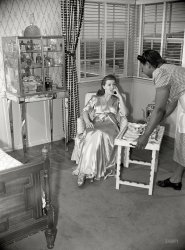
- Alex Chilton: 1911
- ... of the 3rd Battalion of the 7th Marines in the Battle of Okinawa, and as a Lt. Colonel and the commanding officer for the 2nd battalion ... Posted by Dave - 07/23/2008 - 4:41pm -
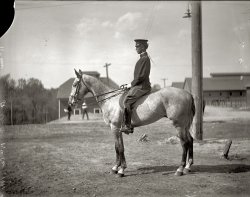
- Off We Go: 1942
- ... including Tarawa, Kwajalein, Eniwetok, Saipan, Guam and Okinawa where she was hit by a Kamikaze killing many men. My father was one of ... Posted by Dave - 04/03/2015 - 7:44am -
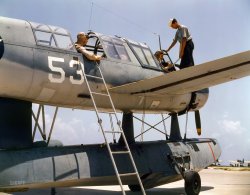
- Sushi anyone?
- ... wares in what was called "black market alley". Naha City, Okinawa c.1969
Went there, did that I was at Naha Air Base, Okinawa, during 69-70, in the 21st Tactical Airlift Squadron. Poked around a ... Posted by treefrogdk - 01/17/2012 - 12:54pm -
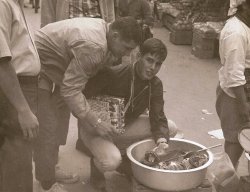
- Two Platoons: 1943
- ... My grandfather served aboard the YMS-299 in the Battle for Okinawa. I have several of his photos and am trying to figure out where they ... Posted by anthonydpaul - 09/20/2011 - 12:30am -
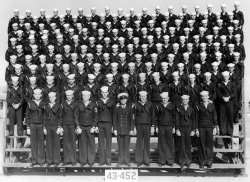
- Cap'n Jack: 1961
- ... "Cap'n Jack" Katibah. Photo taken on or around Kadena AFB, Okinawa in 1961. The finest man who ever drew breath in my estimation, we lost ... Posted by BamBam - 03/03/2011 - 2:24pm -
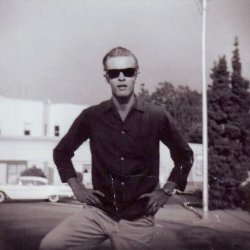
- Wedding Day: 1966
- ... at 19 years old, right before my dad was shipped off to Okinawa for 2 years. View full size.
Sweet What a nice shot of your ... Posted by jmanelis01 - 11/12/2010 - 1:44pm -
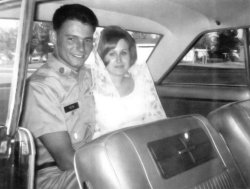
- Somewhere in San Diego
- ... Korea, Vietnam, Back to Olongapo and then to Sasebo and Okinawa -Kadena - I flew from Kadena to Castle AFB in early Jan 1966.
... Posted by brianvnt90 - 10/13/2011 - 7:26am -
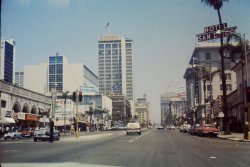
- WWII Air Field
- ... Japanese kamikaze planes airfields during the assault on Okinawa.
Born Feb. 25, 1924, in Oskaloosa, Iowa, to William F. and Adah M. ... Posted by Christoph Traugott - 02/10/2017 - 8:10pm -
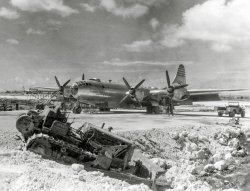
- The Happy Couple: 1948
- ... and the sinking of the USS Little (DD803) off the coast of Okinawa by kamikazes 3 years previous. A native of Akron Ohio, he passed away ... Posted by Truck5man - 01/25/2012 - 4:16pm -
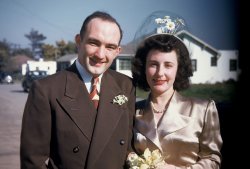
- Dad on the Town: 1945
- ... in the invasions of the Gilbert Islands, Saipan, and Okinawa, then were part of the Occupation forces.
The Shasta Cola bottles, ... Posted by Cazzorla - 11/20/2015 - 7:48pm -
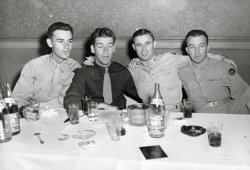
- What's Playing?
- A movie theater entrance in Futenma, Okinawa, about 1957. Taken from one of my Dad's badly faded Ektachrome slides. ... Posted by Groucho - 12/14/2011 - 1:55pm -
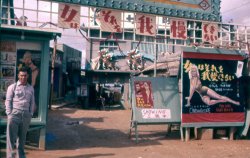
- Fun with Santa: 1958
- ... where we lived for the 15 months Dad was stationed on Okinawa. Not the kindliest Santa I have ever seen. View full size.
... Posted by noelani - 09/16/2011 - 1:57pm -
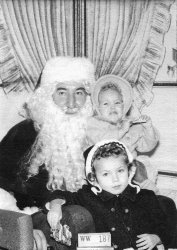
- USAF buddies at Suicide Cliff
- ... (?) Karst, me, and a fella named Peek at Suicide Cliff, Okinawa 1/1/69. Quite an adventurous day!
(ShorpyBlog, Member Gallery) ... Posted by treefrogdk - 01/17/2012 - 12:50pm -
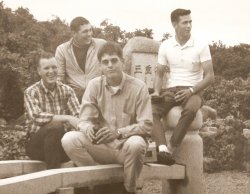
- Machinist Mates: 1942
- ... convoys, the Normandy invasion, and Kamikazi attacks at Okinawa. Ten days after the surrender Anne Arundel steamed into Tokyo Bay. ... Posted by DoninVa - 01/23/2016 - 12:10am -
